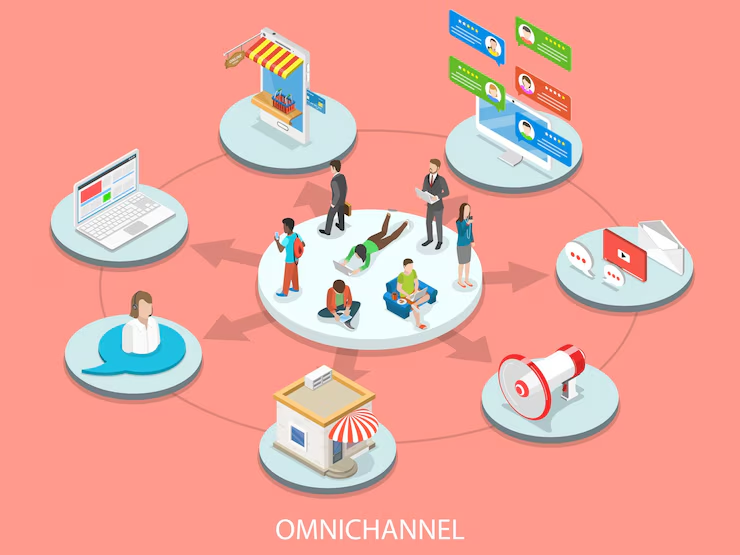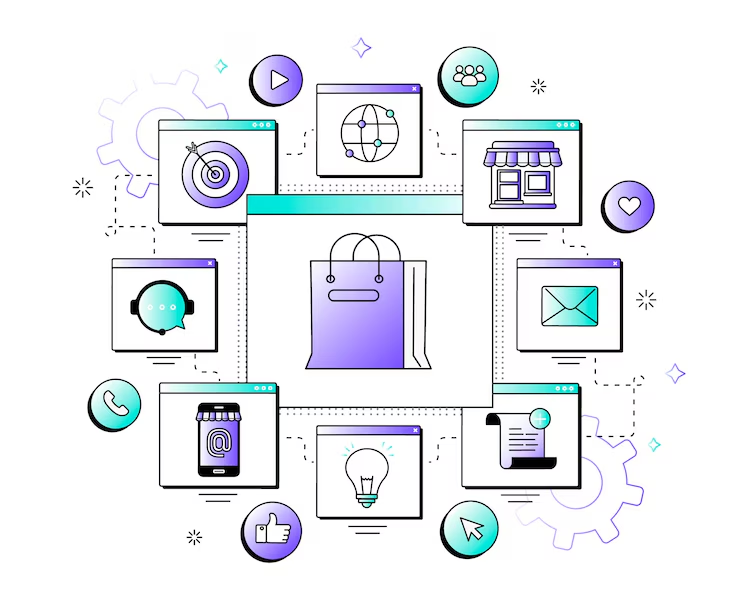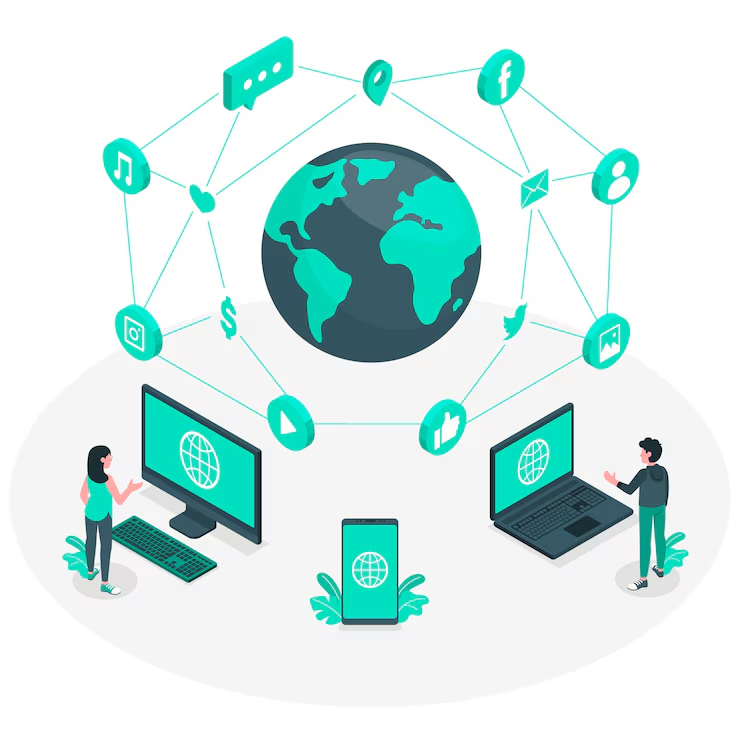In today's increasingly digital landscape, small and medium-sized enterprises (SMEs) are no longer limited by their size or resources. Instead, they have significant opportunities for breakthrough growth thanks to modern technologies – particularly automation and omnichannel integration.
Automation helps save time, reduce errors, and improve operational efficiency. Meanwhile, an omnichannel strategy delivers a seamless customer experience across all touchpoints, from online to offline, social media to websites, and traditional stores.
This article will provide a clearer understanding of how combining these two elements can drive comprehensive growth for SMEs – a smart, effective, and sustainable approach in today's highly competitive environment.
1. Benefits of automation for SMEs

Save time and resources
Automation helps eliminate repetitive tasks such as data entry, sending emails, and basic customer service... Thanks to that, the HR team can focus on more strategic tasks, enhancing the value of their work.
Increasing efficiency and reducing errors
Machines and software operate according to standardized processes, helping to minimize human error. This is particularly important in activities such as order processing, inventory management, and invoice generation.
Optimizing customer experience
Through automated processes like instant chatbot responses, timely customer care emails, or automatic order status updates, businesses can create a more seamless, professional, and personalized experience for customers.
Data-driven decision making
Many automation tools integrate real-time data analysis and reporting capabilities. SMEs can easily monitor performance, customer behavior, and adjust strategies flexibly and accurately.
Facilitating calability
Once processes are standardized and automated, scaling business operations becomes less burdensome. SMEs can grow rapidly without needing to hire or invest excessively in operational infrastructure.
Areas where SMEs can implement automation:
Marketing:
- Email marketing automation (scheduled email sending, customer segmentation).
- Social media management (post scheduling, engagement tracking).
- Initial customer support chatbots.
Sales:
- Lead nurturing.
- Automation of quotation and order processes.
- Sales performance tracking and analysis.
Customer Service:
- Help desk ticket systems.
- Self-service portals.
- Automated responses for frequently asked questions (FAQs).
Operations:
- Automated inventory management.
- Automation of payment and invoicing processes.
- Project and task management.
2. The benefits of Omnichannel for SMEs

Expanding target customer reach
Customers can initiate their shopping journey from anywhere – Facebook, Zalo, TikTok, Google, website, or physical stores. With an omnichannel strategy, SMEs can intelligently establish a presence where their target customers frequently interact, thereby increasing their ability to reach and attract potential clients.
Creating a seamless shopping experience
Omnichannel allows customers to transition flexibly between channels – for example, browsing products on social media, placing orders via the website, and picking up their purchases in-store. This seamlessness enhances customer satisfaction and strengthens customer loyalty.
Personalizing the customer experience
When customer data from multiple channels is synchronized, SMEs can gain a clear understanding of each individual's behavior, needs, and purchase history. This creates opportunities to personalize marketing campaigns, offers, and customer care – thereby improving conversion rates.
Optimizing advertising and sales costs
With centralized data, businesses can measure the effectiveness of each channel and optimize their marketing budget. Furthermore, centralized management helps save on personnel and operational costs, while also minimizing the risk of errors in order processing or inventory management.
Increasing revenue and scaling rapidly
Thanks to multi-channel accessibility and a superior customer experience, omnichannel enables SMEs to easily expand their market reach and increase revenue without requiring significant investment in new personnel or infrastructure.
3. Key channels in SMEs' Omnichannel strategy

- Website & E-commerce: This serves as the central platform for showcasing products, processing orders, and collecting customer data. A website helps build a professional brand image and creates a reliable destination in the purchasing journey.
- Social Media (Facebook, Instagram, TikTok, Zalo...): These are platforms where customers spend a significant amount of their daily time. These channels enable SMEs to promote their brand, interact directly with customers, run advertising campaigns, and even sell directly on the platform.
- E-commerce Marketplaces (Shopee, Lazada, Tiki...): These are sales channels with a large existing user base, helping SMEs expand their market share quickly. It's crucial to synchronize product listings, inventory, and orders across these platforms to avoid errors and stockouts.
- Traditional Stores (Offline): If SMEs have physical stores, connecting their data with the online system is extremely important. This facilitates easy and seamless management of orders, loyalty programs, returns, and exchanges.
- Email, SMS & Chatbots: These are effective channels for nurturing and retaining customers after a purchase. SMEs can send personalized offers, order updates, birthday promotions, etc.
4. How SMEs build effective Omnichannel strategies

Identify the target customer profile
Before implementing any channel, SMEs need a clear understanding of:
- Who their customers are.
- Where they typically engage (Facebook, Shopee, physical stores, etc.).
- Their purchasing behaviors and expectations.
Developing a customer persona will help you select the right channels for more effective outreach and interaction.
Choose relevant channels and start with your strengths
It's not necessary to launch on all channels simultaneously. Begin with:
- Your existing channels (Facebook, offline store, website, etc.).
- The platforms where your customers have a significant presence.
- Platforms where you can effectively control content and processes.
After optimizing these initial channels, gradually expand to others to ensure a seamless customer journey.
Integrate and synchronize data systems
An effective omnichannel approach requires interconnected information across all channels:
- Customer data, order information, and inventory are synchronized.
- The shopping experience remains consistent even when customers switch channels.
- It's easy to manage and analyze the entire customer journey.
Tools such as CRM systems and multi-channel sales management software (e.g., Sota ERP, KiotViet) can be very beneficial.
Ensure a consistent customer xperience
Customers need to perceive consistency in:
- Brand image.
- Communication style (tone, responsiveness).
- Sales policies (pricing, promotions, returns, etc.).
- Order processing speed and after-sales support.
Whether a customer interacts on Facebook or in a physical store, they should experience professionalism and reliability.
5. Combining automation and Omnichannel - doubled power

5.1 The synergy between automation and Omnichannel
Automation and an omnichannel strategy are not just two separate technological trends in modern business; they are also two elements that can create significant synergy when combined effectively. This mutual reinforcement helps businesses improve operational efficiency, optimize customer experience, and increase competitive advantage in the market.
Automation optimizes Omnichannel operations
Automation plays a crucial role in coordinating and ensuring consistency across sales and customer service channels within the omnichannel model. Specifically:
- Cross-channel Customer Data Management: CRM systems automatically collect and analyze data from various channels (website, social media, email, physical stores, etc.), helping to create a comprehensive customer profile.
- Personalizing Customer Experience: Through marketing automation tools, businesses can send relevant messages to the right people at the right time, based on their interaction behavior across different channels.
- Optimizing Operational Processes: Automatically processing orders, tracking inventory, responding to messages and emails, etc., helps minimize errors and increase the speed of customer service across all touchpoints.
Omnichannel extends the value of automation
Conversely, an omnichannel strategy creates a favorable environment to maximize the potential of automation solutions:
- Increasing Input Data for Automated Systems: Multiple customer touchpoints provide the system with more data to learn from, thereby improving the accuracy of automated algorithms such as customer segmentation, behavior prediction, or product recommendations.
- Enhancing the Continuity of Automated Experiences: Whether customers switch from online to offline channels or vice versa, the automated system can maintain a seamless and consistent experience.
- Expanding the Scope of AI/ML Applications: With integrated channels, businesses can apply artificial intelligence tools to automate not only marketing but also customer care, sales support, and after-sales service.
5.2 Benefits of SMEs integrating both
Optimize efficiency and resource savings
Through automation, SMEs can operate omnichannel strategies more effectively without the need for increased headcount. All processes, from marketing and sales to after-sales service, experience reduced timelines and minimized errors.
Personalize customer experiences at scale
Automation enables the personalization of content (emails, offers, messages, etc.) based on customer behavior across various channels – a feat difficult to achieve manually as the business grows.
Rapid response – enhanced satisfaction
When customers message via Facebook, Zalo, web chat, etc., they receive near-instantaneous responses thanks to chatbots and automated scripts. This improves the customer experience and increases conversion rates.
Easy measurement and improvement
Data from multiple channels is centralized, allowing SMEs to track performance, measure the ROI of each campaign, understand the customer journey clearly, and continuously improve based on real-time data.
Build a solid foundation for long-term growth
With standardized and synchronized processes, businesses can easily scale their model, expand into new markets, or implement long-term CRM strategies without facing operational bottlenecks.
6. Challenges and solutions for SMEs in implementation

Integrating automation and an omnichannel strategy offers numerous benefits for businesses, particularly in enhancing customer experience and operational efficiency. However, small and medium-sized enterprises (SMEs) often encounter significant difficulties during implementation due to limited resources and technological capabilities. Below are some common challenges and feasible solutions:
Challenges
- One of the most significant obstacles for SMEs is the constraint of budget and technological resources. They often lack the financial capacity to invest in comprehensive automation platforms and integrated omnichannel systems, as well as the absence of dedicated IT professionals to deploy and operate these technological solutions.
- Furthermore, many small businesses lack a well-structured data management system, leading to fragmented and unsynchronized data across channels. This reduces the effectiveness of automation solutions and personalized customer experiences.
- Difficulties also arise from integrating sales and service channels. SMEs commonly utilize various platforms such as websites, Facebook, Zalo, e-commerce marketplaces, etc., but lack a unified system. This lack of connectivity can easily disrupt the customer journey and diminish management efficiency.
- Finally, the reluctance to change cannot be overlooked. Many small businesses still adhere to traditional management methods, fearing the risks and costs associated with adopting new technologies, leading to delays in digital transformation.
Solutions
- An effective approach is to select technology solutions that align with the scale of the business. SMEs can start with cost-effective and easy-to-deploy SaaS (Software-as-a-Service) platforms such as HubSpot Free, Zoho CRM, Haravan, Sapo, or Mailchimp.
- Businesses should focus on core channels with high efficiency, such as Facebook or their website, for initial implementation, and then gradually expand to other channels. This phased approach helps minimize risk and optimize initial investment costs.
- SMEs should also leverage domestic technology partners – entities that understand the Vietnamese market and provide tailored solutions. These partners often offer technical support and training services, helping businesses save time and effort.
- Finally, investing in internal training and mindset shifts is a crucial factor. Businesses need to encourage employees to learn and participate in training courses on digital transformation, marketing automation, and omnichannel management to enhance implementation and operational capabilities.
7. Conclusion
Automation helps save time, reduce operational costs, and increase work efficiency. Meanwhile, omnichannel delivers a seamless and consistent experience across all customer touchpoints. When combined effectively, these two elements create a flexible, efficient, and customer-centric business ecosystem – something every business needs for sustainable growth in the digital age.
Despite the challenges that may arise during implementation, with an innovative mindset, the selection of appropriate technology, and a clear roadmap, SMEs can fully leverage the significant potential of automation and omnichannel – not just to survive but also to achieve outstanding growth in the digital era.